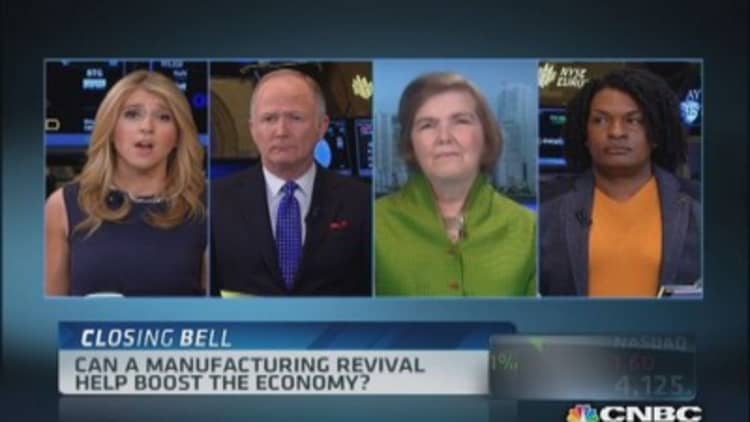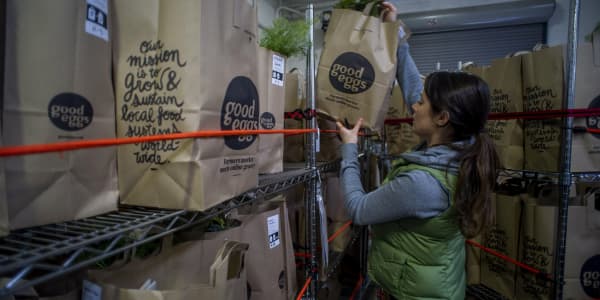One bet on the economy is that American manufacturing is staging a comeback. With labor costs rising in China, U.S. companies are taking a second look at operations and incorporating more domestic production.
Now in a twist on "Made in USA" and the larger reshoring movement, more small to mid-sized U.S. businesses are making and exporting goods as part of their growth strategy. Six years after the recession began, the U.S. recovery is patchy. A measure of Americans working, and those seeking jobs—the labor force participation rate—has tumbled to near 35-year lows.
More business owners are canvassing this new normal and thinking: We need to export.
Large multinationals have been exporting for decades. Now, even smaller companies based in smaller cities—thanks to e-commerce and access to ports—are courting international markets. Inside regional U.S. airports, entrepreneurs are boarding international flights to pitch products. Workers at U.S. ports are loading more containers, packed with everything from U.S.-origin lumber to glass.
A Pennsylvania company is shipping building materials to Mongolia. It's one of the coldest countries, where effective home insulation is a big challenge. A Tennessee business is ramping up patterned glass production, destined for churches and homes in South America and Europe. A Florida maker of porcelain lighting is not only exporting but has opened an Australian outpost after orders climbed. Only a handful of U.S. companies make porcelain lighting and opaque patterned glass, with the bulk of such production is in China.
More businesses are making bigger bets on exports, as many American consumers spend cautiously.
"Every company needs a fallback contingency plan," said Eric Kerney, president of Heritage Glass in Kingsport, Tennessee. "Our contingency plan is we can diversify."
And this direction of "Made in USA" goods overseas is contributing to the post-recession recovery. "Manufacturing is key to providing jobs and driving the economy," said Bryan Scott, co-owner of Barn Light Electric based in Titusville, Florida.
"Even small companies are participating and exporting their products to China," said Hal Sirkin, senior partner at The Boston Consulting Group in Chicago.
Read MoreHey ladies, want a hot career? Become a welder
Global manufacturing is shifting. And one key reordering of winners and losers is the narrowing gulf between China and the U.S.
Triggered by changes in wages and energy costs, the difference between China and U.S. in manufacturing costs—before transportation—has narrowed to less than five points, as recently measured by the consulting group in an April report. A decade ago, that gap between the U.S. and China was wider at 14 points, said Sirkin, who led the research.
"It used to be that if you said more or less you wanted a low-cost manufacturer, you go to South America and Asia. If you wanted a high-cost manufacturer you go to Europe and the U.S.," Sirkin said. "That's no longer true."
Diversifying through a modest recovery
Of course domestic manufacturing gains have yet to replace the thousands of U.S. jobs lost to overseas markets.
New reshoring of jobs back to the U.S. combined with offshoring reached a virtually flat net level last year, said Harry Moser, president of the Reshoring Initiative, which monitors U.S. manufacturing. "The bleeding has stopped," said Moser, whose firm tracks both small and large businesses.
Read More Millions of Americans aren't working. Why?
But exports, in fact, continue to rise and reached record levels in March, according to the U.S. Census. U.S. exports have been growing seven times faster than GDP since 2005, Boston Consulting notes.
And that growth may be just beginning as manufacturers take advantage of stable wages and lower energy prices in the U.S. For example, the U.S. pays at least 40 percent less than the rest of the world for natural gas and electricity, key ingredients in manufacturing.
That's in part why the U.S. is on track to become one of the developed world's top low-cost manufacturers, lapping parts of Europe and Japan, according to research from the Boston Consulting Group.
From Tennessee to South America
One entrepreneur firmly staking a claim on U.S. export gains is Heritage Glass' Kerney.
In Tennessee, Kerney's glass business is reopening a 100-year-old manufacturing plant that has been shuttered for two years. Tucked amid the Appalachians, Kingsport was founded after the Civil War to capitalize on expanding rail lines and increased trade. Their industrial heritage includes glass making, and Heritage Glass is slated to ramp up production by summertime, and hire about 120 workers. Patterned glass is used in everything from table tops to solar panels.
Kerney envisions 60 percent to 70 percent of sales eventually coming from such regions as the Philippines, Europe and South America. He's not waiting for the U.S. housing recovery to solidify.
Heritage Glass is less than six hours from Savannah, Georgia, a port town, which connects exports to international markets. "We're not far from water," Kerney said.
Such targeted efforts at growing exports can work, and have contributed to the recovery. Exports accounted for 54 percent of output growth in the top 100 U.S. metro areas from 2009 to 2012, compared with 37 percent nationally for that period, according to a report last year from the Brookings Institution.
American cities that are exporting a lot, not surprisingly, are highly specialized. In other words, making a specific widget that a pocket of the world wants gets you a bite of the global economy.
That's what happened to Barn Light Electric. Based near the Kennedy Space Center, the business of about 125 employees survived the government shutdown last year with domestic and international growth. Owners noticed more orders from Australia. In some cases, customers were paying more on shipping than for the actual lamp.
About a year ago, Barn Light opened an manufacturing shop in Melbourne. American parts and materials are shipped overseas, where a handful of trades people in Australia assemble the lamps for regional customers.
Total international sales account for roughly 10 percent of sales. They also export to Canada and Mexico among other countries. Their products have even been shipped to high-end hotels in China and Hong Kong.
Read MoreHow one entrepreneur is reviving 'Made in USA' wool
For now, China is a leader in lower-priced goods. But not only is China facing rising labor costs, Kerney and other entrepreneurs argue customers want more than just cheap prices. They want quality, too. The whole package.
From Pennsylvania to Mongolia

Mark Reginelli is director of world trade for the 84 Lumber Company. With a staff of about 3,000, they're a lumber and buildings material supplier based in Eighty Four, Pennsylvania. He's traveled the world for housing projects and has experience building in emerging economies, and after natural disasters such as Hurricane Katrina.
In 2009 he traveled to Mongolia. Thanks to its mining industry, the economy was booming.
"Every person I met was interested in U.S.-style construction," Reginelli said. The appetite for cheaper options from China and Russia was waning for some builders in Mongolia.
"We wanted to introduce U.S quality housing solutions and management in construction development," said Purevjav Tsogtsaikhan, then working for the Mongolian housing authority. He met 84 Lumber in 2008 and become a local sales representative for the company in 2011.
The company erected its first town homes in Mongolia last year. "All of the products came from the United States, down to the carpeting," Reginelli said.
It has been shipping internationally since 1998. But as the economic recovery unfolded, Reginelli started to poke around for a Plan B. "The housing crisis has helped us look at other opportunities that were out there," he said.
The company pocketed about $2.2 billion in revenue last year, with international sales accounting for about 1 percent of that pie. It has sights on more international markets. "After using the least expensive product, now they're saying we need a higher quality product," Reginelli said.
—By CNBC's Heesun Wee. Follow her on Twitter @heesunwee, and Facebook.





